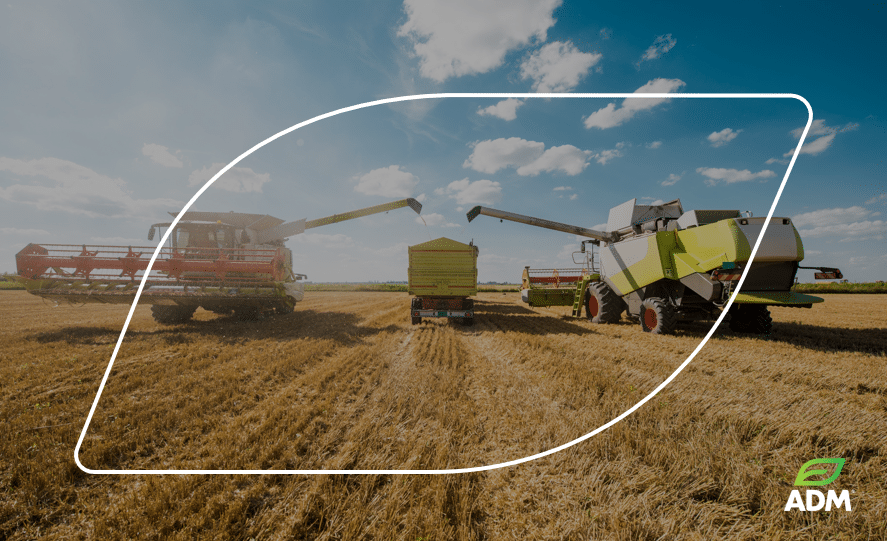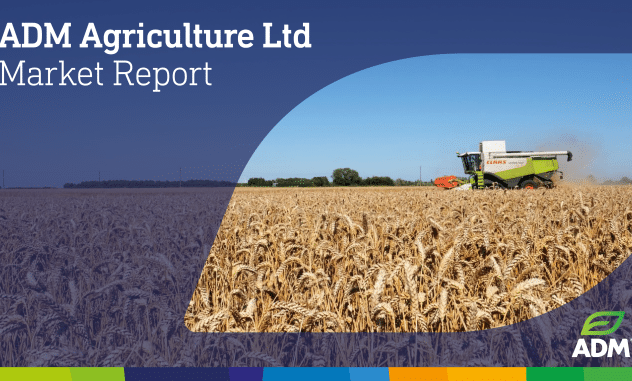WELCOME TO THE ADM AGRICULTURE WEEKLY MARKET REPORT
Wheat
- Despite a ‘bounce’ on the month’s first trading day, Chicago wheat has traded down just over $7/t w/w. Last Friday saw the US release quarterly stocks and updates on grain production, which were deemed bearish to the market. US wheat production was increased by just over 2mln t, with increases for all three wheat classes. With quarterly stock coming in just above expectations, the US market reacted strongly on the downside posting a new 2-year low. US wheat exports remain routine, and although they are running 29% lower y/y, the current pace is still in line with the seasonal projection.
- European prices are down €7/t w/w, mainly driven by the weaker US markets and a firmer euro/US$ spread. Reports detail that 2 more ships are heading to Ukrainian ports, using the humanitarian corridor set up by the Ukraine, and defying Russian threats to target vessels in the area.
- Ten vessels have completed journeys without incident over the past weeks, allowing total exports to reach 6.82mln t so far this season. Russian officials also reported record shipments of wheat in September of 5.8mln t, bringing the season-to-date figure to an impressive 15.3mln t. However, EU exports struggling with the aggressive offers from the Black Sea have only reached 7.39mln t a/o Oct 1, compared with 9.77mln t a year earlier.
- UK market continues its weary path, following the lead from other exchanges. UK market has traded down just over £6/t w/w, although spot premiums remain firm, primarily due to a lack of producer selling.
- The North/South market differential is enabling grain to be shifted further afield, although the Northern markets are now competing with imported maize prices. For the South/ East we remain some way from being export competitive, and this has been evident with the EU Commission releasing data that showed the EU had imported only 100kmt of wheat from the UK in the first quarter (July-Sept) of the current marketing season.
Malting Barley
- Not much new to say about malting barley markets on the week. Price action has been largely sideways, and for another week demand does not appear interested in buying. Meanwhile, farmer selling is feeling a lull.
- The market is still digesting samples from this year’s harvest, and as yet we still do not have a fully accurate picture of the final crop quality.
- Quality premiums remain attractive against historical levels, and we would suggest look like a good sell for growers that have the quality in the barn, particularly in the Jan-Mar and Apr-Jun positions.
Feed Barley
- Global barley markets are slow. Russian feed barley is trading at a significant discount to the European market into North Africa/Middle East, keeping the EU from pricing into exports.
- Feed barley markets are slow for another week as domestic consumers remain elusive, meanwhile, export demand still sits circa €5 below UK levels.
- Farmer selling is sporadic, but we expect this to change in the coming weeks as cash flow requirements should bring some selling pressure to the market. Once they do, unless demand steps back into the frame, we expect that barley will have to push lower to find demand outlets.
Rapeseed
- A quiet week brought little movement to markets this week. A bearish USDA report on Friday brought a negative feel to the end of the week with quarterly stocks over 20 million bushels higher than the expected 243.55m at 268m. Soybean stocks on farm came in at 72 million bushels, up 14% from last year. Off-farm stocks are 196 million bushels, 7% lower. Harvest progress for US soybeans is at 23% as of Sunday 1 October still ahead of average pace.
- Energy markets have seen a large drop this week despite the continued reduction of crude stocks in this week’s EIA report. Demand concerns have seen slight relief following US economic data suggesting a lower demand outlook for quarter four. Veg oils have been mixed this week with palm lower and Soyoil marginally higher as we have seen weakness in crude oil. Some larger palm-producing countries expect lower production next year due to heat from El Nino.
- Canola has mainly followed the wider complex this week, overall lower. Harvest continues with favourable weather and better-than-expected yields, however, farmers are not keen on selling at these levels.
- MATIF Rapeseed has tried to push higher again this week but struggled alongside weakness from crude oil. We see a very similar story with little farmer selling to be seen, especially in the UK as prices remain at least £25-30 away from farmers targets.
- Sterling trades at 1.15500.
Oats
- EU oat markets have seen further gains this week as consumers continue to offset buying orders from their retail customers.
- Offers of milling oats are becoming hard to find as sellers look to assess what they need to sell in the Q4 and Q1 positions.
- Feed oats remain at a huge premium over other feed grains, however, buyers in Spain have lowered their buying ideas following the arrival of several cargoes in recent weeks.
- Here in the UK millers continue to have gaps to fill in nearby positions but farmer selling remains very slow and this is supporting prices.
- The quality of the UK crop remains a concern with much of the spring crop being only fit for feed usage.
- Bottom line, the market remains tight globally with a large reduction in production in the key oat-producing nations, however lower feed usage could have a dampening effect on prices as time progresses and millers look to use the lower quality that is available.
Pulses
Peas
- Despite yields being down YoY across all peas, barring yellows, quality has remained excellent across the board with seasonally low averages on bleaching, cracked seed coat, and insect damage.
- This has resulted in feed peas being few and far between and as a result, is keeping feed pea prices at a strong level versus other feed pulse options.
- In the U.K. Consumers are looking for cover for the Q4 position, please contact your farm trader should you have any feed peas available!
- Human consumption premiums are still firm over that high feed value with options for pre-Christmas still available should you have any open market peas available, contact your farm trader for more information.
- Europe has a strong demand for sub10% green peas which is keeping prices high to aid with the supply, Marrowfats continue to hold their firm values with customers in Asia looking to supply for their most popular period pre-February 2024.
- Our Long Sutton facility has just completed its first run of large blue peas again with successes surrounding quality which we thank all our dedicated growers for. Next week we will move on to Winter Beans for splitting before heading onto yellow peas and then Marrowfats.
- 2024 buybacks are still available, with our new marrowfat variety ‘Adder’ being booked up quickly post-harvest, so please look to book asap to avoid disappointment. Green peas now have new terms available to offer with some hectarage of the variety ‘Butterfly’ available.
- Please contact your farm trader for more information.
Beans
- Little changes week on week, prices are stagnant at these levels currently and the farmer is not engaging at their usual rate year on year for feed beans.
- We continue to work on enquiries but are still out on price by 5-10 euros vs the Baltic origins.
- Human consumption-wise, offers are coming out of Africa for the spot positions, however similarly to feed, UK prices appear to be too high to capture that demand.
- High insect damage and poor colour retention means HC beans are few and far between, though we are keen buyers of any quality beans be that either feed or human consumption.
- Again, please contact your farm trader for more information.
Seed
- Availability is limited across all major winter wheat varieties, with KWS Extase and KWS Dawsum selling particularly well this year.
- Champion, from DSV, has also been a firm favourite with its extreme vigour giving the flexibility to push back drilling date. KWS Cranium and LG Redwald are also varieties that are popular in the later drilling slot, as such we expect demand for both varieties to increase over the next few weeks.
- We are now beginning our final runs of seed production, so we would urge you to cover seed requirements for any last-minute cropping decisions as soon as possible.
Fertiliser
- India will soon announce a new urea import tender as the government is keen to ensure supply security.
- The Urea market has been fairly flat since India’s RCF failed to secure the volumes it required in the last tender. Buyers remain cautious of the forward trend and have stayed on the sidelines, but once India does arrive, this is likely to tempt other buyers back in.
- Urea prices in the forwards are looking to move higher if all buyers that still need to cover Q4 tonnes arrive together. The future direction of natural gas prices also remains a worry to many.
- Ammonia markets are higher than previous weeks with a 54% increase seen in FOB Caribbean spot contracts from last week.
- Phosphate buyers continue to wait for an official announcement from India’s government over P&K nutrient-based subsidy. An expected cut could result in a drop in demand from India and help to set a price ceiling.
- Potash prices seem to have peaked with Southeast Asia stable as European prices are unwilling to move higher.
- UK fertiliser markets remain quiet but with reportedly strong seed sales and continued drilling, this indicates that further demand will appear in Q4 2023, Q1 2024.
| £/€ | £/$ | €/$ |
|---|---|---|
| 1.1555 | 1.2170 | 1.0530 |
| Feed Barley £ | Wheat £ | Beans £ | Oilseed Rape £ | |
|---|---|---|---|---|
| Nov 2023 | 160-170 | 179-189 | 225-235 | 345-350 |
NB: Prices quoted are indicative only at the time of going to press and subject to location and quality.
“Although ADM Agriculture takes steps to ensure the validity of all information contained within the ADM Agriculture Market Report, it makes no warranty as to the accuracy or completeness of such information. ADM Agriculture will have no liability or responsibility for the information or any action or failure to act based upon such information.”
ADM Agriculture cannot accept liability arising from errors or omissions in this publication.
ADM Agriculture trade under AIC contracts which incorporate the arbitration clause.
Terms and Conditions of Purchase.
On every occasion, without exception, grain and pulses will be bought by incorporating by reference the terms & conditions of the AIC No.1 Grain and Peas or Beans contract applicable on the date of the transaction. Also, we will always, and without exception, buy oilseed rape and linseed by incorporating by reference the terms & conditions of the respective terms of the FOSFA 26A and the FOSFA 9A contracts applicable on the date of the transaction. It is a condition of all such transactions that the seller is deemed to know, accept, and understand the terms and conditions of each of the above contracts.


